The Retail Merchants of Canada versus the Mail-order
Catalogue
| |
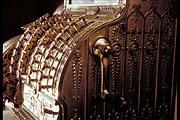 |
|
| |
 This
cash register, in the collection of the Canadian Postal Museum, was used
at the post office and general store of Val Morin Station, Quebec. This
cash register, in the collection of the Canadian Postal Museum, was used
at the post office and general store of Val Morin Station, Quebec.
|
|
| |
|
|
|
by John
Willis
The mail-order catalogue brought an increasingly varied
and
modern selection of goods to the homes of Canadians. It was so successful
that
it threatened the livelihood of a more vulnerable brand of retailers, the
small
country merchants. Their livelihood became a big issue, nationally and
politically.
Introduction | Organized
Opposition to Mail Order | Harry Stevens, Champion of
Small
Business | The Royal Commission on Price Spreads |
The
Bigness of Business | The Competition: Unfair? | Did
They Pay Their Fair Share of Taxes? | Small-town
Friends and
Enemies | East versus West | Clergy
Support
of Independent Retailers | Conclusion | Further
Reading
Introduction
The mail-order catalogue brought an increasingly varied and modern
selection
of goods to the homes of Canadians from coast to coast. Everyone, it
seemed,
could jump on the mail-order bandwagon. This was especially true of rural
areas
and small towns where there were no large department stores.
The catalogue afforded farmers, miners, and loggers and their families
an
opportunity to buy a vast array of goods, but, at the same time, it
threatened
the livelihood of small-town merchants who had difficulty competing with
mail-order
houses and were put out of business as a result.
In 1934, matters came to a head. Retail merchants mounted an offensive
against
mail-order corporations and big-city department stores that resulted in a
parliamentary
enquiry. It eventually led to a full Royal Commission. The issue of small
versus
big business was on everyone's lips during the 1935 federal
election. The
Reconstruction Party was created to defend small businesses that were
experiencing
hard times during the economic downturn of the 1930s.
Organized Opposition to Mail Order
In the late 19th century, agitation against big retailers was rampant
in the
U.S. and Canada. The movement started in the U.S. and subsequently spilled
over
into Canada, where the Retail Merchants Association (RMA) was founded in
November
1896. The RMA demonstrated a long-standing opposition to the mail-order
catalogue,
which it viewed as unfair competition in the local economy.
| |
 |
|
Inside the Dazé
General
Store,
Arnprior, Ontario, 1910. This merchant stood to lose quite a lot due
to the competition from big-city mail-order companies, which could send
groceries and canned goods to its customers through the mail.
|
 |
|
In a 1911 petition, the RMA called on the Post Office to protect retail
merchants
from the mail-order houses:
|
Mail Order Houses, who make their living out of mail order business,
are having
a large portion of the cost of the delivery of their goods paid out of the
Public
Treasury for their benefit, and at the expense of those retail merchants
who
establish businesses in cities, towns and villages for the benefit of the
public
as well as themselves, and who are subject to legitimate expenses which
the Mail
Order Houses are not subject to. In other words, the Government is
subsidising
Mail Order Houses, and assisting in destroying those Retail Merchants who
are
endeavouring to build up Canada, and who are helping to create modern
community
life.
|
In 1926, the RMA proposed that the federal government introduce a
ten-per-cent
tax on mail-order companies and distribute the proceeds to the provinces
according
to the volume of mail-order business.
The Post Office department was aware of the controversial nature of
mail order.
In 1923, an internal proposal to lease advertising space in post offices
across
Canada would have prevented the department from accepting advertising for
mail-order
businesses, as well as tobacco, beer, and liquor.
| |
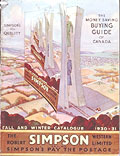 |
|
Simpson's casts a long
shadow
on the landscape. In the 1930s, Simpson's introduced the suburban
mail-order
office in three Ontario locations: Brampton, New Toronto, and Oshawa.
Around 1933, sales were $286 000. The offices were operated by commission
agents, who had a vested interest in drumming up business. Simpson's
Fall/Winter Catalogue, 1930-31, cover.
|
 |
|
|
Harry Stevens, Champion of Small Business
| |
 |
|
| |
 Harry
H. Stevens began his political career in British Columbia as a strong
opponent of oriental immigration. Harry
H. Stevens began his political career in British Columbia as a strong
opponent of oriental immigration.
|
|
| |
|
|
|
During the 1930s, with the economy in a depression, Canadians
desperately
looked for culprits and solutions. Various left-wing and right-wing
approaches
were proposed. Harry Stevens, member for Kootney East and Minister of
Trade and
Commerce in the Bennett cabinet, emerged as the champion of small
business.
In January 1934, Stevens spoke in Toronto to a convention of shoe
merchants
and manufacturers. He criticized big commercial businesses, particularly,
"the
practise of mass buying of huge department and other chain store
organizations,
and the use of this power in the destruction of the small retailer ... and
the
crushing of the manufacturer who will not accept price dictation of the
mass-buyer."
He alluded to sweat-shop practices in the clothing industry as a means of
bringing
costs down and the requirements of mass buyers for the cheapest prices
possible.
The presidents of Eaton's and Simpson's lashed out at
Stevens
in the press the next day. Events unfolded swiftly. Prime Minister Bennett
instituted
a select committee of the House of Commons to do something about the
Depression
before the next federal election.
The select committee's mandate was to enquire into the large
spread
between the amounts received by producers and those paid by consumers, the
assumption
being that some force was artificially raising the prices at the expense
of the
consumers. Its proceedings were front-page news across Canada for about
four
months.
The business practices of large corporations, including food-processing
giants
such as Canada Packers, as well as Eaton's and Simpson's, were
investigated.
Witnesses made sweeping statements in favour of independent retailers. One
called
them "the most important factors in our system of
distribution."
The National Fair Trade Council generally regarded "the growth of
large
department store organizations, mail order houses and chain stores as
detrimental
to the general interests of the country."
The Royal Commission on Price Spreads
That July, the select committee became a full-blown Royal Commission.
Stevens
again presided over proceedings. The Retail Merchants Association played
an important
behind-the-scene role, providing witnesses and advice. Its monthly
magazine was
enlisted to supply additional information to the Commission. The
Commission was
so successful that top executives from Eaton's and Simpson's
complained
about Stevens to the Prime Minister. By January 1935, Bennett and Stevens
had
a falling out. Bennett probably worried that Stevens's crusading
reformist
position was alienating corporate backers of the Tory party. But, he was
also
worried about Stevens as a potential challenger for the leadership of the
party.
Early in 1935, Stevens was forced out of the cabinet. In the ensuing
fall
election, he retained his seat and ran as leader of the newly formed
Reconstruction
Party. The party held large rallies: 10 000 in Toronto, 5300 in Winnipeg
and
2000 to 3000 each in Calgary, Saskatoon, and Regina. Militants of the RMA
and
other small-business lobby groups were active in his campaign. However,
the party
was only able to garner 389 000 votes (less than nine per cent of the
popular
vote), roughly the same as the CCF. The Liberals received two million
votes while
the Conservatives garnered 1.3 million votes.
Stevens lost his bid to reinvent the politics of the country in 1935.
Nevertheless,
the testimony he heard and included in the Commission's report
provides
an interesting perspective from which to view the antagonism between big
and
small business underlying the whole debate for and against mail order.
The Bigness of Business
| |
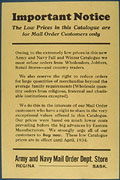 |
|
| |
 This
notice addressed to Army and Navy customers in the 1930s was, from a
country merchant's point of view, provocative to say the least. Army
and Navy Fall/Winter Catalogue, 1933-134. This
notice addressed to Army and Navy customers in the 1930s was, from a
country merchant's point of view, provocative to say the least. Army
and Navy Fall/Winter Catalogue, 1933-134.
|
|
| |
|
|
|
In 1929, three companies were responsible for 80 per cent of all
department
store sales in Canada: T. Eaton Co., Robert Simpson Company, and
Hudson's
Bay Company. Eaton's and Simpson's were very active in mail
order.
HBC stopped publishing its seasonal mail-order catalogues in 1913 and
operated
a limited mail-order business. Department stores accounted for 10 per cent
of
the Canadian retail market in 1929, 12.6 per cent two years later.
Evidently,
the early years of the Depression worked to the advantage of department
stores,
possibly at the expense of smaller general stores and retail shops.
| |
 |
|
| |
 Was
discretion the better part of receiving your Eaton's order? Perhaps,
given the opposition to the catalogue in certain quarters, it was. Eaton's
Fall/Winter Catalogue, 1911-12, p. 2. Was
discretion the better part of receiving your Eaton's order? Perhaps,
given the opposition to the catalogue in certain quarters, it was. Eaton's
Fall/Winter Catalogue, 1911-12, p. 2.
|
|
| |
|
|
|
Eaton's alone accounted for 7 per cent of all retail sales
in Canada
in 1930. It was the personification of big business in Canadian retailing
with
its 13 large department stores, 5 mail-order distribution centres, 32
smaller
department stores, 7 factories, 9 buying offices (some overseas), and 112
mail-order
offices. Simpson's was the second largest firm with its flagship
store
in Toronto, 3 major mail-order facilities, and several manufacturing
companies,
among them a pharmaceutical company. It too had buying offices overseas.
|
The Competition: Unfair?
Eaton's and Simpson's operated at a scale so large that
they
were able to obtain goods from manufacturers at cut-rate prices. They
could then
sell via catalogue or over the counter at the lowest prices. Eaton's
and
Simpson's sometimes sold items at a loss in order to attract
business.
This technique of selling, known as the "loss leader," is
still commonly
practised today.
| |
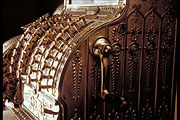 |
|
| |
 Money,
the ultimate bone of contention, was the business of rural customers
and was what the small merchants and mail-order houses were fighting
over. Money,
the ultimate bone of contention, was the business of rural customers
and was what the small merchants and mail-order houses were fighting
over.
|
|
| |
|
|
|
Small-time retailers were unable to compete with these low prices. A
merchant
in Nova Scotia was frustrated by the competition: "Mass buying by
the larger
retail department stores has placed me in a position where I cannot
compete with
mail order prices. Although I pay cash for my wants by borrowing at times
from
the bank, we independent merchants can sell the goods if we only can
compete
with mail order prices. I have been trying for years to buy to compete and
no
success."
An Alberta merchant wrote the premier in 1936: "Yes sir,
business is
simply hell for the little man, nowadays." Times were tough, but even
when
they were not so bad, the competition from the big corporations did not
seem
fair. Eaton's, for example, could accumulate huge stocks, which, by
means
of economies of scale and price leverage, allowed the company to compete
in virtually
every corner of the rural economy. As if this was not enough, the business
practices
of the large mail-order operations were at times unorthodox.
The Saskatchewan RMA accused Army and Navy, a department store and
mail-order
operation based in Regina, of practising false advertising in its radio
spots
and billboard publicity campaigns. Eaton's of Winnipeg was accused
of issuing
contracts to area correctional facilities, where female inmates made
blouses
and mattress covers free of charge. Conditions in Eaton's company
factories
were considered appalling.
| |
 |
|
Army and Navy advertisement
from the Regina Leader Post, February 23, 1934. The document was one
of many exhibits presented before the Royal Commission on Price
Spreads.
|
 |
|
Did They Pay Their Fair Share of Taxes?
Whether in Summerside, PEI, Quebec, or Saskatchewan, the refrain among
retail
merchants was the same. Mail-order companies were not paying their fair
share
of taxes. As a result, the burden of public responsibility fell
inordinately
upon the shoulders of local businessmen.
| |
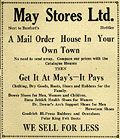 |
|
| |
 Advertisement
from the Stettler Independent, November 1, 1928. Many stores
offer better prices than the catalogue houses! Advertisement
from the Stettler Independent, November 1, 1928. Many stores
offer better prices than the catalogue houses!
|
|
| |
|
|
|
|
|
The Manitoba chapter of the RMA believed that business and realty tax
assessments
on the Eaton's complex in Winnipeg were based on estimates that were
nowhere
near their true value. The Summerside Board of Trade recommended that the
British
North America Act be amended to empower the provincial government to tax
mail-order
companies. The Independent Retail Association, on the other hand, proposed
that
the federal government collect taxes on mail order. The RMA's Quebec
chapter
proposed a five-dollar tax on all catalogues.
The charge that mail-order companies were not conducting themselves as
good
corporate citizens did not flow only from a preoccupation with the need to
balance
the municipal tax base. Much more was at stake, including a commitment to
the
rural way of life that small town businessmen and their allies in the
Reconstruction
Party were trying to preserve.
Small-town Friends and Enemies
| |
 |
|
| |
 Front
page of the Stettler Independent, November 22, 1928, encouraging
loyalty to community business. Front
page of the Stettler Independent, November 22, 1928, encouraging
loyalty to community business.
|
|
| |
|
|
|
Small-town merchants viewed themselves as the backbone of rural
communities.
Their economic health reflected the economic and social health of the
entire
community. The community was part urban - townspeople and villagers
-
and part rural - residents of surrounding farms and bush. Merchants
explained
how blacksmiths bought at the local grocery, the grocer traded with the
farmer,
the farmer had his horses shoed at the blacksmith, and so on. The economic
balance
was overturned when some of the rural community purchased goods and
services
outside the village economy.
The result could spell disaster, at least as far as the Canadian
Grocer
was concerned in 1913:
|
The towns and villages where business is stagnant and where the
citizens send
away for the cream of their requirements is dead. Dead socially,
financially,
intellectually. The citizens lack confidence and interest in each other.
They
do not co-operate. They do not reciprocate. They cease to be enterprising,
overlook
the rights of their neighbours, and neglect to look properly after their
own;
in short become slovenly and careless and degenerate.
|
The view of a community closed in upon itself increased a
community's
distrust of outsiders and newcomers, who might be of a different religious
faith
or background, or who hailed from a different part of the country. They
were
easily recognized.
East versus West
| |
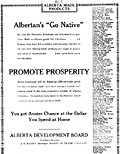 |
|
| |
 Buy-Alberta
Advertisement from the Red Deer Advocate, November 27, 1929. Buy-Alberta
Advertisement from the Red Deer Advocate, November 27, 1929.
|
|
| |
|
|
|
In the Canadian West, Eaton's and Simpson's were perfect
targets
for irate independent retailers. The companies were big, competitive, and,
above
all, from Ontario. Their profits invariably drifted back to the East at
the expense
of local (western) interests. How satisfying it must have been for a
Lethbridge,
Alberta, newspaper to point out that during the First World War,
Eaton's
did not donate to the local chapter of the Red Cross, but to the Red Cross
in
Winnipeg, where the company had its regional headquarters.
The local newspaper was a natural ally of the country merchant, like
Matt
Stanley, the fictitious small-town newspaperman in W. O. Mitchell's
Roses
are Difficult. Here, editors had no difficulty understanding where
the interests
of their newspaper lay, namely on the main streets of their communities.
Main-street
businesses bought much of the advertising space in the local paper.
Newspapermen
and advertisers rubbed shoulders in their day-to-day living, at church, at
home,
at school, and at the nearby watering hole.
Clergy Support of Independent Retailers
| |
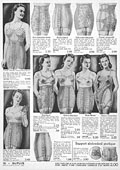 |
|
| |
 French-Canadian
Catholic clergy objected to the graphic depiction of the human body,
especially the female body, in some catalogues. In some instances, mothers
were encouraged to keep such pages from the sight of their children,
especially the boys. Dupuis Frères Catalogue, 1944, p. 16. French-Canadian
Catholic clergy objected to the graphic depiction of the human body,
especially the female body, in some catalogues. In some instances, mothers
were encouraged to keep such pages from the sight of their children,
especially the boys. Dupuis Frères Catalogue, 1944, p. 16.
|
|
| |
|
|
|
Another natural ally of the independent retail movement was the
Protestant
and Catholic clergy. Protestant clergymen appeared on the podium with
Harry Stevens
of the Reconstruction Party throughout the federal election campaign of
1935.
Stevens's championing of the "little guy" in his
characteristic
Methodist tone no doubt appealed to them.
In Quebec, the Catholic clergy condemned the catalogue as an example of
consumerism
and excessive self-indulgence. Catalogues contained pages where the human
body
was shown too explicitly. Spending on catalogue goods interfered with the
necessary
and morally good task of saving at the local credit union. Housewives were
advised
to throw their catalogues in the garbage.
Catholic priests were not alone in expressing their moral opposition to
catalogue
companies. The minister of the Knox Presbyterian church in Portage La
Prairie,
Manitoba, wrote an irate letter to the Hudson's Bay Company in 1916
because
the company published a price list of mail-order liquors on the very day
that
a ban on liquor sales in the province of Manitoba came into effect.
In this and other instances, there was a moral unease with the
catalogue.
This sense of unease was part of a general feeling of angst, as the
traditional
establishment of rural and small-town Canada saw its leadership coming
apart
at the seams.
Conclusion
Surprising indeed was the depth of feeling on the catalogue issue, as
well
how much the story of the opposition to the catalogue has to tell us about
the
history of our country, both from the turn of the 20th century onward and
during
the troubled decade of the 1930s.
The movement against Eaton's and Simpson's demonstrated the
extent
of social malaise throughout rural society at a time when all of Canada
was increasingly
dominated by big-city interests and preoccupations. The issue was, from
the retailers'
point of view, economic. However, it also had strong moral (clerical) and
political
overtones. The career of one politician, Harry Stevens, literally rose and
fell
on the issue. With him, seemingly the fortunes and aspirations of
small-town
and rural Canada also rose and fell.
Historians regularly point to the rural angst experienced by French
Canadians
during the early and middle part of the 20th century as they adapted their
rural
tradition to a new urban-industrial way of life. The experience was
characterized
by much frustration and hardship. The history of the opposition to the
mail-order
catalogue reminds us that English Canadians inhabiting rural communities
also
experienced their own version of hard times as the bright lights of the
big city
began to shine upon them.
Further Reading
D'arcy, Hande. "Saskatchewan Merchants in the Great Depression:
Regionalism
and the Crusade against Big Business." Saskatchewan History
43(1)
(Winter 1991): 21-33.
Marchand, Suzanne. Rouge à lèvre et pantalon: Des
pratiques
esthétiques féminines controversées au Québec
de
1920-1939. Les cahiers du Québec. Montréal:
Hurtubise,
1997.
Morod, David. Store Wars: Shopkeepers and the Culture of
Mass
Marketing, 1890-1939. Toronto: University of Toronto, 1996.
Report of the Royal Commission on Price Spreads. Ottawa:
Printer
to the King's Most Excellent Majesty, 1935.
Rudin, Ronald. "Alphonse Dejardins et le marketing des caisses
populaires,
1900-1920." In La culture inventée: Les
stratégies
culturelles aux 19e et 20e siècles,
edited
by Pierre Lanthier et Guildo Rousseau, pp. 173-186. Québec:
I.Q.R.C.,
1992.
Wetherell, D. G. Main Street and the Evolution of Small Town
Alberta,
1880-1947, Edmonton: University of Alberta Press, 1995.
|